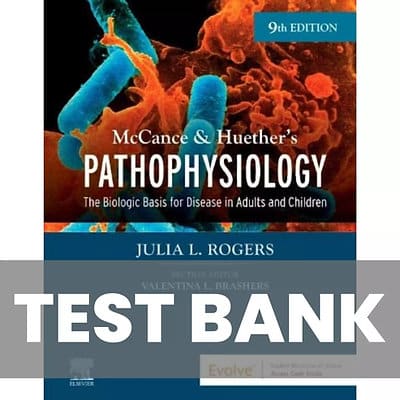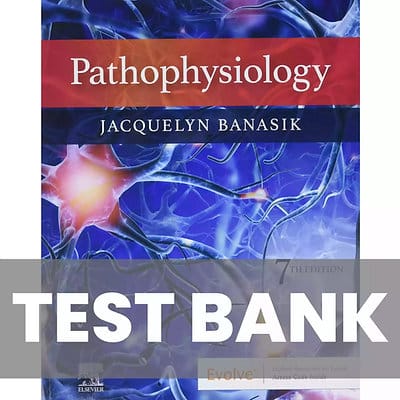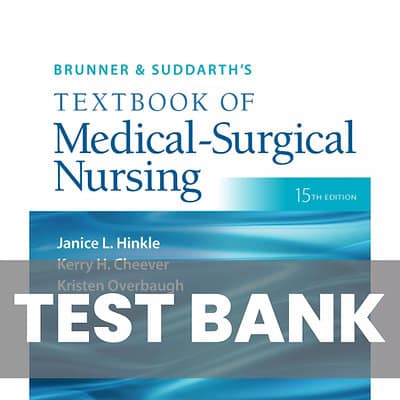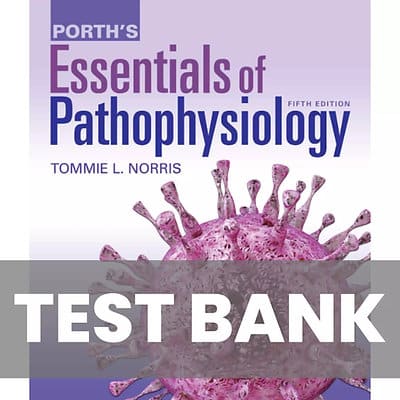McCance & Huether’s Pathophysiology 9th Edition – Test Bank
Chapter 1: Cellular Biology
MULTIPLE CHOICE
1. Which statement best describes the cellular function of metabolic absorption?
Cells can produce proteins.
c. Cells can take in and use nutrients
b. Cells can secrete digestive enzymes.
4. Cells can synthesize fins.
ANS: C
In metabolic absorption, all cells take in and use nutrients and other substances from their surroundings. The remaining options are not inclusive in their descriptions of cellular metabolic absorption.
PTS: 1
REF: Page 2
2. Most of a cell’s genetic information, inchiding RNA and DNA, is contained in the:
Mitochondria
b. Ribosome
c. Nucleolus
4. Lysosome
ANS: C
The nucleus contains the nucleolas, a small dense structure composed largely of RNA, most of the cellular DNA, and the DNA-binding protrins, such as the histones, which regulate its activity. The other options do not contain most of a cell’s genetic information
PTS: 1
REF: Page 2
3. Which component of the cell produces hydrogen peroxide (HO) by using oxygen to remove hydrogen atoms from specific substrates in an oxidative reaction?
a. Lysosomes
c. Ribosomes
Peroxisomes
4. Oxyhydrosomes
ANS: B
Peroxisomes are so named because they usually contain enzymes that use oxygen to semove hydrogen atoms from specific substrates in an oxidative reaction that produces HO, which is a powerful oxidant and potentially destructive if it accumulates or escapes from peroxisomes. Ribosomes are RNA-protein complexes (nucleoproteins) that are synthesized in the nucleolus and secreted into the cytoplasm through pores in the nuclear envelope called muclear pore complexes. Lysosomes are saclike structures that originate from the Golgi complex and contain more than 40 digestive enzymes called Aydrolases. which catalyze bonds in proteins, lipids, mucleic acids, and carbohydrates. Oxyhydrosomes are involved in enzyme production.
PTS: 1
REF: Page
4. Which cell component is capable of cellular autodigestion when it is released during cell injary?
Ribosome
Smooth endoplasmic reticulum
b. Golgi complex
4. Lysosomes
ANS: D
The lysosomal membrane acts as a protective shield between the powerful digestive enzymes within the lysosome and the cytoplasm, preventing their leakage into the cytoplasmic matrix. Disruption of the membrane by various treatments or cellular injury leads to a release of the lysosomal enzymes, which can then react with their specific substrates, causing cellular self-digestion. The other options do not correctly describe this process
PTS: 1
REF: Pages 74
5. What is the sequence of steps in the development of a digestive enzyme by the pancreas cells from the initial transcription to the release from the cell?
The enzyme is transcribed from DNA by RNA in the nucleus, proceeds to the ribosome for synthesis, and is transported in a secretory vesicle to the cell
b. The enzyme is transcribed from RNA by DNA in the nucleus, proceeds to the lysosome for synthesis, and is transported in an encapsulated membrane to the cell membrine
The enzyme is transcribed by the mitochondria in the nucleus, proceeds to the ribosome for synthesis, and is transported in a cytoskeleton to the cell membrane.
d. The enzyme is transcribed from DNA by RNA in the nucleus, proceeds to the Golgi complex for synthesis, and is transported in a cytosol to the cell membrane.
ANS: A
The enzyme is transcribed from DNA by RNA in the nucleus, proceeds to the ribosome for synthesis, and is transported in a secretory vesicle to the cell membrane. The other options do not correctly describe this process.
PTS: 1
REF: Page Fig 1-5
6. During which phase of the cell cycle is DNA synthesized?
10
c.
4. M
ANS: B
The four designated phases of the cell cycle are: (1) the G1 phase (Ggap), which is the period between the M phase (M-mitosis) and the start of DNA synthesis; (2) the S phase (S-synthesis), during which DNA is synthesized in the cell nucleus; (3) the G phase, during which RNA and protein synthesis occurs, the period between the completion of DNA synthesis and the next phase (M); and (4) the M phase, which includes nuclear and cytoplasmic division
PTS:
REF: Page 37
7. What organic compound facilitates transportation across cell membranes by acting as receptors, transport channels for electrolytes, and enzymes to drive active pumps?
Lipids
b. Proteases
Proteins
ANS: C
4. Carbohydrates
Proteins act as (1) recognition and binding units (receptors) for substances moving in and out of the cell; (2) pores or transport channels for various electrically charged particles called tons or electrolytes and specific carriers for amino acids and monosaccharides; and (3) specific enzymes that drive active pumps that promote the concentration of certain ions, particularly potassium (K”), within the cell while keeping concentrations of other sons, for example, sodium (Na), below the concentrations found in the extracellular environment. The other options do not correctly describe this process.
PTS: 1
REF: Page 13 Page 15
8. Understanding the various steps of proteolytic cascades, such as caspase-mediated apoptosis and complement cascades, may be useful in designing drug therapy for which bruman diseases?
A Cardiac and vascular disorders
Autoimmune and malignant disorders
c. Gastrointestinal and renal disorders
d. Endocrine and gastrointestinal disorders
ANS: B
Understanding the various steps involved in this process is cruciall for designing drug interventions. Dywegulation of proteases features prominently in many human diseases, including cancer, autoimmunity, and neurodegenerative disorders. The other options do not comectly describe this process.
PTS: 1
REF: Page 15
9. Which structure prevents water-soluble molecules from entering cells across the plasma membrane?
Carbohydrate chains
Membrane channel proteins
b. Glycoprotein channels
4. Lipid bilayer
ANS: D
The bilayer’s structure accounts for one of the essential functions of the plasma membrane. It is impermeable to most water-soluble molecules (molecules that dissolve in water) because the water-soluble molecules are insoluble in the oily core region. The bilayer serves as a barrier to the diffusion of water and hydrophilic substances while allowing lipid-soluble molecules, such as oxygen (O;) and carbon dioxide (CO), to diffuse through it readily. The other options do not comectly describe this process.
775: 1
REF: Pages 12-13
10. The fod mosaic model explains How a cell membrane functions
b. Why our bodies appear to be solid
c. How tissue is differentiated
4. How to moves between the intracellular and extracellular compartments
ANS: A
The fid mosaic model accounts for the flexibility of cellular membranes, their self-sealing properties, and their impermeability to many substances. The remaining options do not explain the mosaic model
PTS: 1
REF: Page 12 What’s New box
11. Which form of cell communication is used to communicate within the cell itself and with
other cells in direct physical contact? Protein channel (gap junction)
Plasma membrane-bound signaling molecules (involving receptors)
c. Hormone secretion such as nerotransmitters
d. Extracellular chemical messengers such as ligands
ANS: A
Cells communicate by using hundreds of kinds of signal molecules, for example, insulin. Cells communicate in three main ways they display plasma membrane-bound signaling molecules (receptors) that affect the cell itself and other cells in direct physical contact The other options do not correctly describe this process.
PTS: 1
REF: Page 20
12. Which mode of chemical signaling uses blood to transport communication to cells some distance away?
Paracrine
b. Autocrine
Neurotransmitter
4. Hormonal
ANS: D
Chemical signaling can be classified into three categories: (1) local-chemical mediator, (2) hormone, and (3) neurotransmitter in the local-chemical mediator model, the secreted chemical acts on the cells in the immediate environment. Hormones we used for communication with distant target cells. For example, cells can secrete a chemical and rely on the blood system to deliver the signal to a distant cell. Finally, neurotransmiters are secreted by neurons to stimulate an adjoining cell. For example, a neuron might secrete acetylcholine to stimulate the movement of a muscle cell
PTS: 1
REF: Page 20
13. Which mode of chemical signaling uses local chemical mediators that are quickly taken up, destroyed, or immobilized?
Paracrine
b. Autocrine
Neurotransmitter
4. Hormone
ANS: A
In paracrine signaling, cells secrete local chemical mediators that are quickly taken up destroyed, or immobilized. The other options do not comectly describe this process.
PTS: 1
REF: Page 20
14. Neurotransmitters affect the postsynaptic membrane by binding to
Lipids
Amphipathic lipids
b. Ribosomes
4. Receptors
ANS: D
In each type of chemical signaling, the target cell receives the signal by first attaching to itsreceptors. The other options do not correctly describe this process
PTS: 1
REF: Page 17
15. How do cells receive communication from the extracellular fluid surrounding them?
Protein channel (gap junction)
Plasma membrane-bound signaling molecules (involving receptors)
c. Hormone secretion such as neurotransmitters
4. Chemical messengers such as ligands
ANS: D
Cellular communication can occur by the binding of a chemical massager (a ligand) to a specific membrane receptor that is closely associated with the channel (eg. G proteins). The other options do not correctly describe how cells communicate.
PTS: 1
REF: Pages 21-22
16. When a second message is necessary for extracellular communication to be activated, it is
provided by which one? Guanosine triphosphate (GTP)
b. Adenosine monophosphate (AMP)
c. Adenosine triphosphate (ATP)
4. Guanosine diphosphate (GDP)
ANS: B
The two major second messenger pathways are cyclic AMP (CAMP) and calcium (Ca””).
PTS: 1
REF: Pages 22-23
17. Under anaerobic conditions, what process provides energy for the cell?
Oxidative phosphorylation
c. Lactolysis
b. Glycolysis
Passive transport
ANS: B
Glycolysis produces a net of two molecules of ATP per glucose molecule through the process of oxidation of the removal and transfer of a pair of electrons. The other options do not correctly identify an anaerobic process that provides energy to the cell
PTS: 1
REF: Page 25
18. What is the mechanism by which the energy produced from carbohydrates, proteins, and lipids is transferred to adenosine triphosphate (ATP)?
Anaerobic glycolysis
Oxidative cellular metabolism
c. Oxidative phosphorylation
4. Tricarboxylic acid phosphorylation
ANS: C
Oxidative phosphorylation occurs in the mitochondria and is the mechanism by which the energy produced from carbohydrates, fats, and proteins is transferred to ATP. The other options do not correctly identify the mechanism described in the question
PTS: 1
REF: Pages 27-28













Reviews
There are no reviews yet.